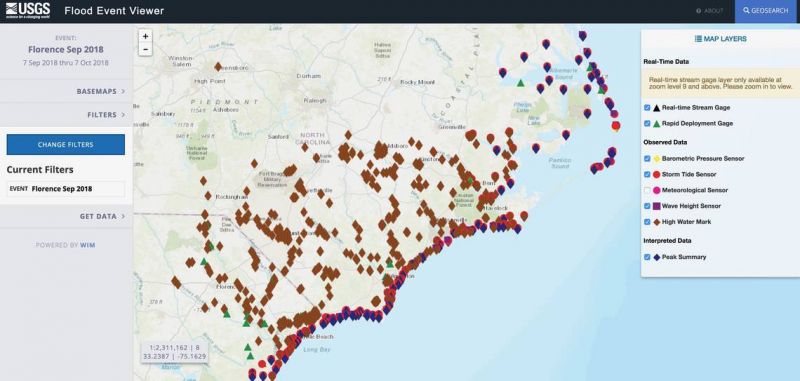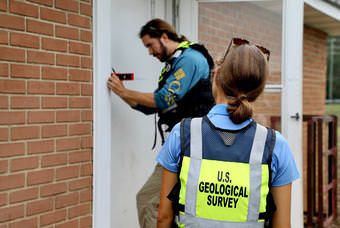USGS Crews Capture Evidence of Carolina Floods
Published on by Water Network Research, Official research team of The Water Network in Case Studies
30 flood experts are in the second week of a high water mark campaign, traveling from one hard-hit community to the next, searching neighborhood by neighborhood and sometimes door to door for physical evidence of flooding.

This flood event viewer, dated Oct. 3, 2018, shows the extent and type of information collected by USGS hydrologists in North and South Carolina in the wake of historic flooding brought on by Hurricane Florence. Credit: USGS. Public domain.
The floodwaters that covered wide swaths of the Carolinas’ coastal plain are finally receding, more than two weeks after Hurricane Florence made landfall Sept. 14 near Wrightsville Beach, North Carolina, and U.S. Geological Survey hydrographers are moving in rapidly to the areas where the flooding lingered longest.
About 30 flood experts are in the second week of a high water mark campaign, traveling from one hard-hit community to the next, searching neighborhood by neighborhood and sometimes door to door for physical evidence of flooding.
The USGS experts are looking for telltale lines of seeds, leaves, grass blades and other debris left behind on buildings, bridges, other structures and even tree trunks as floodwaters recede. Once they find these high water marks, they label them, photograph them, survey them, and record crucial details about them.
The USGS flood experts’ field work is highly skilled and time-sensitive, because high water marks can be obliterated by weather and by property owners’ cleanup efforts. Hydrographers have been in the field collecting high water marks each day since Sept. 18, working mostly in two-person teams and moving as quickly as receding waters and the scope of the work permits. The teams from the USGS South Atlantic Water Science Center, which covers the Carolinas and Georgia, have recorded more than 600 high water marks in North and South Carolina and surveyed at least 365 of those.
Field crews expect to record many more as they move into communities like Conway, South Carolina, where the floodwaters have not yet finished their retreat. You can see some preliminary results of their work at the USGS Flood Event Viewer for Hurricane Florence: https://stn.wim.usgs.gov/FEV/#FlorenceSep2018
Why is this fieldwork important? The physical signs of flooding provide valuable information that can confirm or correct other lines of evidence. Among these are measurements from a network of about 475 permanent and temporary river and streamgages that were in place in North and South Carolina when Florence struck; more than 175 stream and river flow measurements taken by field crews after the storm on flood-swollen rivers, streams and even roads; satellite photos and imagery from unmanned aerial vehicles (or drones); and computer modelled flood projections. Taken together, all this evidence will allow USGS experts to reconstruct precisely where, when, at what depth, and in what volume floodwaters inundated the region.
Right after the storm, the USGS’ early information from high water marks can help emergency managers decide where to locate relief centers, so that aid can reach the most severely affected communities quickly, and can help the U.S. Army Corps of Engineers manage flood control.
In the coming weeks USGS flood information can help the Federal Emergency Management Agency to discern the difference between wind and water damage – important information for property owners and insurers. Over the long term, it can help emergency managers plan better for future floods; improve the computer models used by the National Weather Service to forecast flooding; and provide information used by FEMA to update the nationwide flood zone maps that underpin the federal flood insurance program.

USGS hydrographer Daniel McCay uses a level to
double-check a high water mark on a church door
near Maxton, NC as his USGS colleague Mary Winsor
observes . Credit: Anna Stull, USGS. Public domain.
“I am proud of the USGS staff’s speed, thoroughness and accuracy as they do this essential work in difficult conditions, and under the pressure of time,” said USGS South Atlantic Water Science Center director Eric Strom. “The team began working well before Florence made landfall, when field crews began installing storm-tide sensors along the coast. Right after the storm passed, we mobilized as many as 60 people at a time to fix or relocate streamgages that were damaged or destroyed, monitor the flooding, and work with forecasters and emergency managers to get them the up-to-date flood information they needed. And now, because the rivers have receded so slowly, we’re in the midst of a long high water mark campaign in two states.
“It’s been a sustained, coordinated effort in response to a hurricane that triggered record-setting floods.”
Preliminary USGS data indicates that Florence’s heavy rains resulted in 19 water level records on rivers and streams in North Carolina and 10 records in South Carolina. Rivers that reached or exceeded the major flood stage heights forecast by the National Weather Service included the Cape Fear, Northeast Cape Fear, Neuse, Lumber, Waccamaw, Pee Dee, Little Pee Dee, Black and Lynches rivers
The flooding in the Carolinas was long-lasting, with several rivers experiencing two peaks of high water flow or flood stage. The first one happened as local rainfall flowed into rivers and streams, and the second one came as rain that fell near the rivers’ headwaters worked its way downstream. In Goldsboro, North Carolina, about 100 miles inland from Florence’s landfall, the Neuse River escaped from its banks, crested at 27.6 feet on September 18, and lingered above the 18-foot flood stage mark for almost a week. The last two rivers to peak were both in South Carolina: the Little Pee Dee on Sept. 25 and the Waccamaw River on Sept. 26.
“Unfortunately, our experience dating back to the 1940s shows that the Carolina coastal plain is a flood-prone region,” said the center’s South Carolina-based associate director John Shelton, who was the on-site coordinator for much of the USGS response. “The scientific knowledge we’re gaining now will be put to good use helping to protect lives and property if and when floods strike this area again.”
For more than 125 years, the USGS has monitored flow in selected streams and rivers across the U.S. The information is routinely used for water supply and management, monitoring floods and droughts, bridge and road design, determination of flood risk and for many recreational activities.
To learn more about USGS’ role providing science to decision makers before, during and after #Florence, visit the #USGS Hurricane Florence page at https://www.usgs.gov/florence
Media
Taxonomy
- Disaster Prevention
- Disaster Risk Reduction
- Disaster Relief
- Flood management
- Flood damage
- Flood prediction
- Flood Risk Management
- Flood
- Flood Insurance
- Disasters & Risks
- Disaster Preparedness
- Natural Disaster Insurance
- Flood Modeling
- Flood Mapping